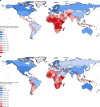Global and regional estimates of orphans attributed to maternal cancer mortality in 2020
- PMID: 36404355
- PMCID: PMC9676732
- DOI: 10.1038/s41591-022-02109-2
Global and regional estimates of orphans attributed to maternal cancer mortality in 2020
Abstract
Despite women being disproportionally affected by cancer deaths at young ages, there are no global estimates of the resulting maternal orphans, who experience health and education disadvantages throughout their lives. We estimated the number of children who became maternal orphans in 2020 due to their mother dying from cancer in that year, for 185 countries worldwide and by cause of cancer-related death. Female cancer deaths-by country, cancer type and age (derived from GLOBOCAN estimates)-were multiplied by each woman's estimated number of children under the age of 18 years at the time of her death (fertility data were derived from United Nations World Population Prospects for birth cohort), accounting for child mortality and parity-cancer risk associations. Globally, there were 1,047,000 such orphans. Over half of these were orphans due to maternal deaths from breast (258,000, 25%), cervix (210,000, 20%) and upper-gastrointestinal cancers (136,000, 13%), and most occurred in Asia (48%: India 15%, China 10%, rest of Asia 23%) and Africa (35%). Globally, there were 40 new maternal orphans due to cancer per 100,000 children, with a declining trend with a higher Human Development Index (range: 121 in Malawi to 15 in Malta). An estimated 7 million children were prevalent maternal orphans due to cancer in mid-2020. Accelerating the implementation of the World Health Organization's cervical and breast cancer initiatives has the potential to avert not only millions of preventable female cancer deaths but also the associated, often-overlooked, intergenerational consequences of these deaths.
© 2022. The Author(s).
Conflict of interest statement
The authors declare no competing interests.
Figures









Similar articles
-
Maternally Orphaned Children and Intergenerational Concerns Associated With Breast Cancer Deaths Among Women in Sub-Saharan Africa.JAMA Oncol. 2021 Feb 1;7(2):285-289. doi: 10.1001/jamaoncol.2020.6583. JAMA Oncol. 2021. PMID: 33355599 Free PMC article.
-
Global, regional, and national age-sex specific mortality for 264 causes of death, 1980-2016: a systematic analysis for the Global Burden of Disease Study 2016.Lancet. 2017 Sep 16;390(10100):1151-1210. doi: 10.1016/S0140-6736(17)32152-9. Lancet. 2017. PMID: 28919116 Free PMC article.
-
Mortality by cause for eight regions of the world: Global Burden of Disease Study.Lancet. 1997 May 3;349(9061):1269-76. doi: 10.1016/S0140-6736(96)07493-4. Lancet. 1997. PMID: 9142060
-
Folic acid supplementation and malaria susceptibility and severity among people taking antifolate antimalarial drugs in endemic areas.Cochrane Database Syst Rev. 2022 Feb 1;2(2022):CD014217. doi: 10.1002/14651858.CD014217. Cochrane Database Syst Rev. 2022. PMID: 36321557 Free PMC article.
-
[SENTIERI - Epidemiological Study of Residents in National Priority Contaminated Sites. Sixth Report].Epidemiol Prev. 2023 Jan-Apr;47(1-2 Suppl 1):1-286. doi: 10.19191/EP23.1-2-S1.003. Epidemiol Prev. 2023. PMID: 36825373 Italian.
Cited by
-
Anticancer Therapies Based on Oxidative Damage: Lycium barbarum Inhibits the Proliferation of MCF-7 Cells by Activating Pyroptosis through Endoplasmic Reticulum Stress.Antioxidants (Basel). 2024 Jun 11;13(6):708. doi: 10.3390/antiox13060708. Antioxidants (Basel). 2024. PMID: 38929147 Free PMC article.
-
Visualizing the effects and causes of caregiver deaths on children in the USA.Nat Med. 2025 Feb;31(2):394-395. doi: 10.1038/s41591-024-03447-z. Nat Med. 2025. PMID: 39794614 No abstract available.
-
Alpha-linolenic acid-mediated epigenetic reprogramming of cervical cancer cell lines.Epigenetics. 2025 Dec;20(1):2451551. doi: 10.1080/15592294.2025.2451551. Epub 2025 Feb 2. Epigenetics. 2025. PMID: 39895102 Free PMC article.
-
The Association Between RACK1 Gene Polymorphisms rs1279736 and rs3756585 in Uterine Cervical Cancer with the Risk Factor of HPV: A Focus on Squamous Cell Carcinoma (SCC).Iran J Pathol. 2025;20(1):24-32. doi: 10.30699/ijp.2024.2019194.3236. Epub 2025 Jan 10. Iran J Pathol. 2025. PMID: 40060229 Free PMC article.
-
Sexually transmitted human papillomavirus and related sequelae.Clin Microbiol Rev. 2025 Mar 13;38(1):e0008523. doi: 10.1128/cmr.00085-23. Epub 2025 Feb 14. Clin Microbiol Rev. 2025. PMID: 39950806 Review.
References
-
- Institute for Health Metrics and Evaluation (IHME). GBD 2019 cause and risk summary. https://www.healthdata.org/results/gbd_summaries/2019 2020.
-
- UNAIDS, UNICEF & USAID. Children on the Brink 2004: A Joint Report of New Orphan Estimates and a Framework for Action (UNICEF, 2004).
Publication types
MeSH terms
Grants and funding
LinkOut - more resources
Full Text Sources
Medical

